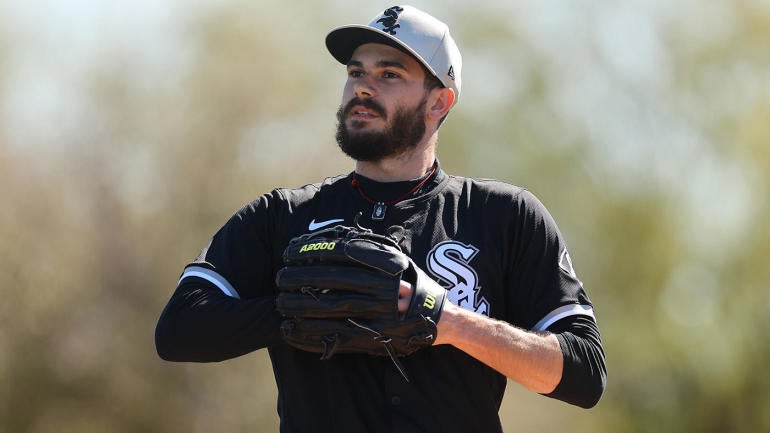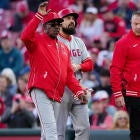
The Padres and White Sox finalized what ought to serve as the final blockbuster of the MLB offseason on Wednesday night in a deal that sends right-handed starter Dylan Cease to San Diego in exchange for a three-prospect, four-player package headlined by two right-handed starters and a teenage outfielder. Cease, who finished second in American League Cy Young Award voting in 2022, had previously been connected to the New York Yankees, Texas Rangers, and others throughout the winter.
As is always the case when a big trade happens, CBS Sports is here to provide instant analysis of the deal by handing out grades to both sides. You can find that below. First, though, let's review the full terms of the trade:
- Padres receive: RHP Dylan Cease
- White Sox receive: RHP Drew Thorpe, RHP Jairo Iriarte, OF Samuel Zavala, RHP Steven Wilson
Now, let's get to it.
Padres grade: A
Cease, 28, was the runner-up for the American League Cy Young Award in 2022. He's also one of a handful of pitchers to notch at least 200 strikeouts in each of the last three seasons. The other members of that club are Corbin Burnes, Gerrit Cole, and Kevin Gausman — or, three of the top pitchers in all of the majors. Cease took a step back last season, posting a 97 ERA+ that registered as his worst full-season mark to date.
The Padres, along with a slew of other teams, wanted Cease all the same because of the belief that there's still proverbial chicken left on the bone. CBS Sports covered that selling point in more detail earlier this winter. One of the reasons teams think Cease could be even better than he has been rests on his elite arsenal. To quote ourselves:
Cease's arsenal features two well-above-average pitches. His fastball clocked in at 95.6 mph last season, and featured nearly 19 inches of induced vertical break. For those new to the IVB metric, that's a fancy way of writing that his heater has a lot of "rising" action to it.
For some perspective on how rare that combination of velocity and rise is, here's a complete list of the other starting pitchers (min. 10 starts) whose fastballs averaged at least 95 mph and 18 or more inches of IVB in 2023:
Cease's sweeping slider, his primary pitch last season, has generated 40% or more whiffs in each of the last three years. In 2023, his slider allowed opponents to hit .216 -- and that represented the worst mark of his career.
Get Cease away from the White Sox and into a more friendly pitching environment -- in terms of the ballpark, the defense, and the infrastructure -- and you might see him quickly improve upon his career 113 ERA+.
If the Padres are to make a serious run at the playoffs this season, they needed their rotation to overperform. They lost 60% of last year's starting five to free agency -- that's Michael Wacha, Seth Lugo, and Nick Martinez, for reference -- and their blockbuster trade that sent outfielder Juan Soto to the New York Yankees netted them two potential mid-rotation arms (Mike King and, well, Drew Thorpe) and a grab bag of back-end and swingmen types.
Cease changes the dynamic. He can slot in alongside Joe Musgrove and King to give the Padres potentially three above-average starters at the front of the rotation. (Here's where we offer the caveat that King, while not lacking in talent, has been spotty with his health.) Will that be enough to guide the Padres back to the postseason? We'll find out. At minimum, it better positions them to make a run both this year and next (oh, right, Cease isn't a free agent until after the 2025 season).
You can question if the Padres, projected to play right around .500 ball, should be moving four players (three of them prospects) for a relatively short-term addition. We appreciate when teams outside of the top tier do what they can to make a push. Besides, the Padres may not have given up either of their top two pitching prospects, depending on the evaluator. (Dylan Lesko and Robby Snelling being the obvious contenders.) A.J. Preller isn't new to inspiring those kinds of questions -- adding Cease makes it more likely that he'll get to continue prompting them for at least another year, too.
White Sox grade: B
As we detailed a few weeks ago, holding onto Cease until the deadline never made sense for the White Sox. The downside risk was too great. Cease might've gotten injured, or had another down year. With the way that teams overvalue team control nowadays, it would've been actively harmful to the potential return to hold onto him -- especially considering that the White Sox have no real competitive aspirations this year.
Whether new general manager Chris Getz was bluffing all along, or the Padres hit him with just the right offer is irrelevant. The bottom line is he ended up making a deal at nearly the last moment -- one that further bolsters a White Sox farm system that has received a fair amount of tender love and care dating back to last deadline.
We wrote up Thorpe earlier this winter, when he was traded from the Yankees to the Padres. In the interest of working smarter, not harder, here's that writeup:
Thorpe, 23, is a former second-round pick who finished last season with five Double-A starts. Overall, he compiled a 2.52 ERA and a 4.79 strikeout-to-walk ratio. Although Thorpe isn't a hard thrower by any measure, he gets by thanks to a high-grade changeup and good command. The Padres have shown they're willing to promote players in an aggressive manner. It would not qualify as a surprise, then, if Thorpe ends up debuting sometime next summer.
Iriarte, 22, split last season between High- and Double-A. He notched a 3.49 ERA and a 2.84 strikeout-to-walk ratio, all the while punching out nearly 27% of the batters he faced. Iriarte has a good fastball-slider combination that he delivers from a low three-quarters slot. He does have a long arm stroke that helps explain why he's struggled with his command. Last year, he walked a batter every other inning. The winds of change have impacted the profile and expectation of the starting pitcher position in recent years, meaning that Iriarte still has a chance to be a mid-rotation starter.
Zavala, 19, split last season between High- and Low-A. He hit .243/.391/.406 with 14 home runs and 21 stolen bases. Those marks don't jump off the page, but it is worth noting that he was more than three years younger than his average opponent at both levels. Zavala is a left-handed hitter with a big leg kick and above-average raw strength. He has struggled with strikeouts throughout his professional career, and his swing-and-miss tendencies could cap his batting average upside. Zavala is young and established enough to foresee him developing into a starting outfielder, likely in a corner.
Wilson, 29, made 102 appearances for the Padres over the last two years. He compiled a 3.48 ERA (114 ERA+) and a 2.34 strikeout-to-walk ratio. Wilson threw his sweeping slider 60% of the time last year, generating a 27.7% whiff rate and holding opponents to a .165 batting average. Wilson has four years of team control remaining. He's likely to best serve the White Sox as a potential deadline trade candidate.
When the Brewers traded Corbin Burnes, a free agent at year's end, to the Orioles for a pair of big-league-ready prospects and a draft pick, we gave them a C and wrote that it felt a piece short. Here, the White Sox received that extra piece. Credit it to Cease's extra year of control, Getz's bluff, or Preller's willingness to pony up as needed. Whatever the case, we think both teams have reason to be content with this deal.






















